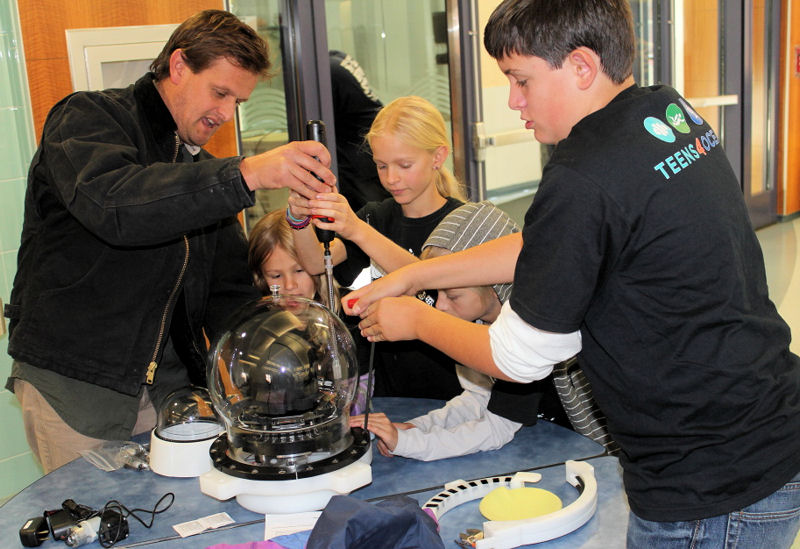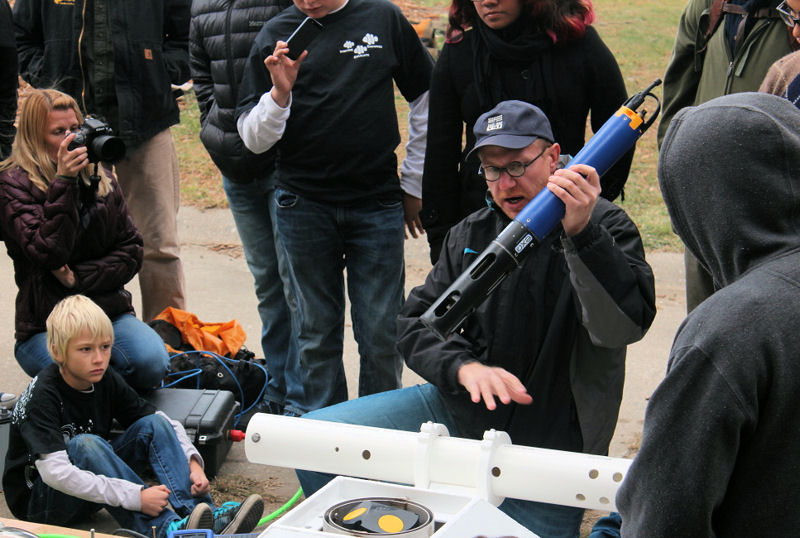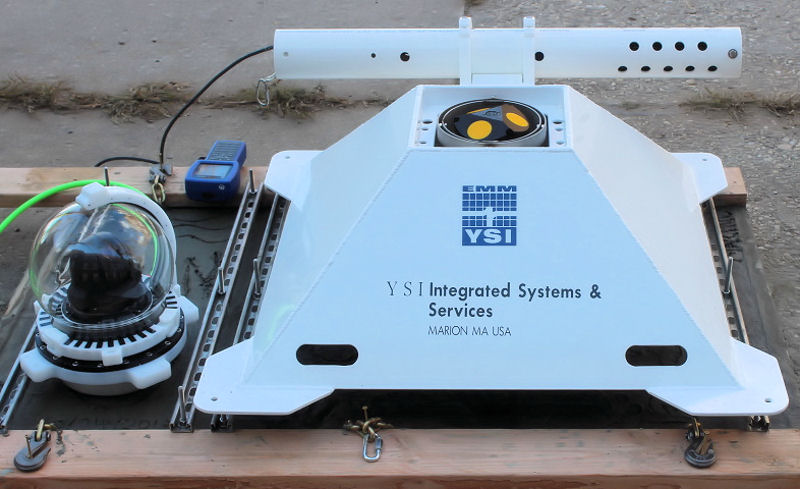
Students examine and help assemble the YSI Integrated Systems and Services (St. Petersburg, Fla.), and Verizon (New York) system that provides water quality data and video of the New York harbor. Photo courtesy of YSI, a Xylem (Rye Brook, N.Y.) brand.
Oysters may soon be making a comeback in New York waterways. And local students are getting their hands wet to help the oysters’ ecological return.
Schools, businesses, organizations, and citizens have teamed up to contribute to the Billion Oyster Project, a long-term effort with the goal of placing one billion oysters into the New York Harbor and other local waterways. During the next 20 years, volunteers will be working to restore native oyster species to improve the ecology and economy of New York’s waterways, according to a Xylem (Rye Brook, N.Y.) news release.
“The Billion Oyster Project showcases effective collaboration between local government, public education, business, and industry,” said Kevin Simpson, senior project manager of Integrated Systems and Services for YSI (St. Petersburg, Fla.), a Xylem brand. “It’s a great example of how we can work together to promote environmental restoration.”
YSI Integrated Systems and Services and Verizon (New York) joined forces for the project. They are providing a system that offers real-time water quality data and video of the harbor floor, according to a Xylem news release.
High school and middle school students lead the restoration effort
The project centers on its founder, The Urban Assembly New York Harbor School (New York). Students from that high school and other volunteers will help grow more than a million oysters each year and transfer them to the harbor. “Here the oysters grow, reproduce, and colonize new ground, leading, eventually, to the return of a self-sustaining oyster population,” the Billion Oyster Project website says.
Oyster growth begins in a hatchery at the school. Three weeks after spawning and fertilization, free-swimming larvae search for and cement onto a substrate — usually another oyster shell. Once attached, the juvenile oysters (also known as spat) are moved to the school’s nurseries for 1 to 2 years. When large enough, the spat are transferred to reef structures that have been built throughout the harbor, the website says.

Barrett Gaylord from YSI, a Xylem brand, teaches NY Harbor School students about the YSI equipment being used for the project. Photo courtesy of YSI, a Xylem brand.
“Having the school’s students leading this initiative helps promote environmental awareness of their local watershed amongst their peers and exposes them to innovative restoration practices. And in this day and age that’s critical,” Simpson said.
Students from other schools also are getting involved. Local middle and high schools have the opportunity to sign up as satellite campuses for oyster restoration. These schools adopt an oyster garden, which is a nursery for 300 to 500 oysters. Teachers take students on field trips to care for the oysters and collect data on oyster growth, water quality, and biodiversity. Schools receive a water quality monitoring kit and curriculum to teach about oyster restoration in classes, the website says. Students also are encouraged to conduct their own research projects and share their results on the Billion Oyster Project website.
“Helping the environment, education, raising awareness of the challenges that face our ecosystems, and bringing native oysters back to New York Harbor, that’s about as good as it gets,” Simpson said.
The Urban Assembly New York Harbor School started the project 4 years ago. So far, 2150 high school and 875 middle school students have helped grow 7.5 million oysters, restore 0.42 ha (1.04 ac) of reef, and recycle 42,457 kg (93,600 lb) of shells. These oysters have filtered about 41 billion m3 (10.9 trillion gal) of water and removed 3 million kg (6.6 million lb) of nitrogen from the harbor, the website says.
Involving the community to fulfill goals

The integrated monitoring platform and underwater camera developed by YSI, a Xylem brand, and Verizon now is being used for the Billion Oyster Project. Photo courtesy of YSI, a Xylem brand.
The project provides teachers with a new educational tool that engages students in science and technology projects and provides volunteers with hands-on green job training. “The purpose of [Billion Oyster Project] is to train young people and local communities to have a role in this long-term process of restoring our harbor and estuary,” the website says.
During weekend restoration events, volunteers from the community work alongside students and teachers to complete such tasks as building and installing reefs, assembling spat collectors, and sorting baby oysters. In addition, companies and organizations are invited to become partners to help make future plans, strategies, and goals for the project. Restaurants are asked to donate shells that larvae can attach to. Volunteers collect donated shells every week and the shells are processed and cured before use. This saves the time and cost needed to obtain shells, which are a limited resource. The collection also reduces costs for restaurants because they don’t need to pay for disposal, the website says.
But as the number of oysters grows, the project has encountered a problem that will require assistance from all its partners and volunteers. “We lack sufficient space for grow-out of juveniles into adults,” the website says. The project operates and supports two medium-scale nurseries, 17 oyster gardens, and two reef sites with a combined capacity of about 13.5 million spat. “We now need to add dozens more gardens and numerous additional acres of reef/on-bottom restoration sites. All of this requires additional resources, partners, permits, and the support of dedicated individuals and volunteers,” the website says.
— Jennifer Fulcher, WEF Highlights








April 10, 2014
Featured